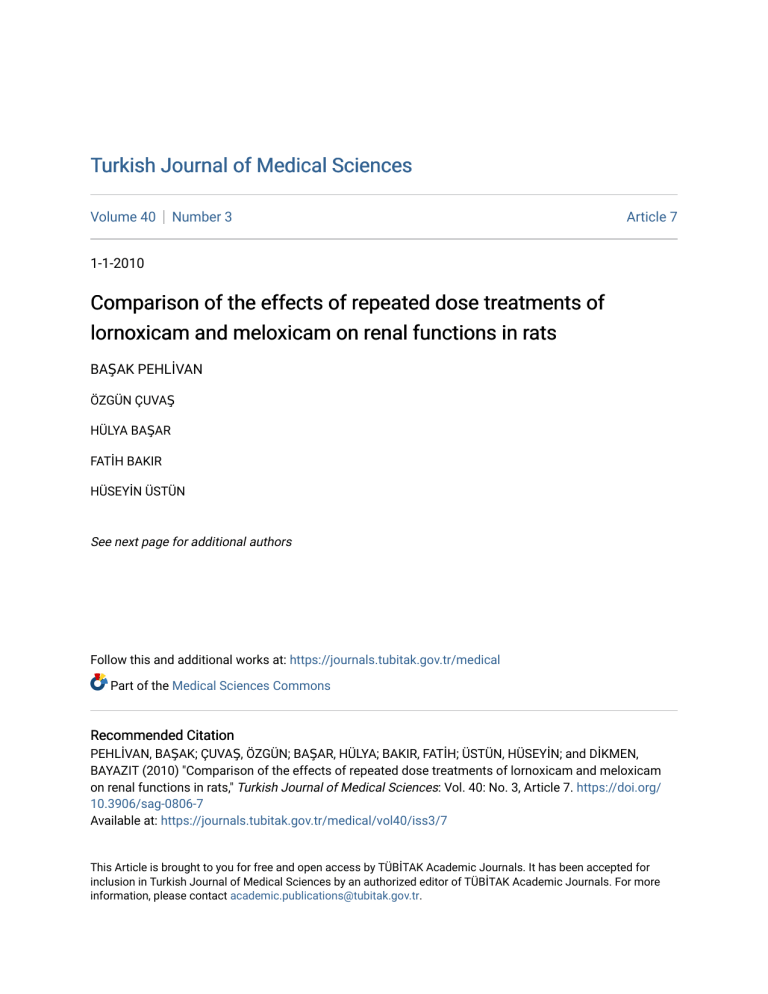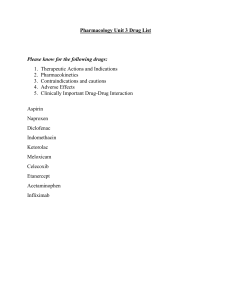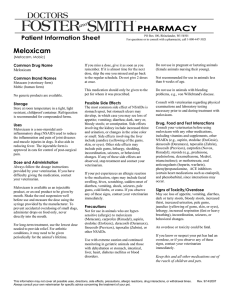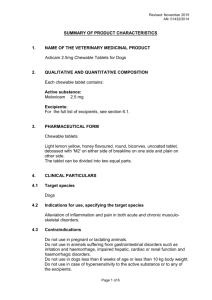
Turkish Journal of Medical Sciences Volume 40 Number 3 Article 7 1-1-2010 Comparison of the effects of repeated dose treatments of lornoxicam and meloxicam on renal functions in rats BAŞAK PEHLİVAN ÖZGÜN ÇUVAŞ HÜLYA BAŞAR FATİH BAKIR HÜSEYİN ÜSTÜN See next page for additional authors Follow this and additional works at: https://journals.tubitak.gov.tr/medical Part of the Medical Sciences Commons Recommended Citation PEHLİVAN, BAŞAK; ÇUVAŞ, ÖZGÜN; BAŞAR, HÜLYA; BAKIR, FATİH; ÜSTÜN, HÜSEYİN; and DİKMEN, BAYAZIT (2010) "Comparison of the effects of repeated dose treatments of lornoxicam and meloxicam on renal functions in rats," Turkish Journal of Medical Sciences: Vol. 40: No. 3, Article 7. https://doi.org/ 10.3906/sag-0806-7 Available at: https://journals.tubitak.gov.tr/medical/vol40/iss3/7 This Article is brought to you for free and open access by TÜBİTAK Academic Journals. It has been accepted for inclusion in Turkish Journal of Medical Sciences by an authorized editor of TÜBİTAK Academic Journals. For more information, please contact academic.publications@tubitak.gov.tr. Comparison of the effects of repeated dose treatments of lornoxicam and meloxicam on renal functions in rats Authors BAŞAK PEHLİVAN, ÖZGÜN ÇUVAŞ, HÜLYA BAŞAR, FATİH BAKIR, HÜSEYİN ÜSTÜN, and BAYAZIT DİKMEN This article is available in Turkish Journal of Medical Sciences: https://journals.tubitak.gov.tr/medical/vol40/iss3/7 Original Article Turk J Med Sci 2010; 40 (3): 371-376 © TÜBİTAK E-mail: medsci@tubitak.gov.tr doi:10.3906/sag-0806-7 Comparison of the effects of repeated dose treatments of lornoxicam and meloxicam on renal functions in rats Başak PEHLİVAN1, Özgün CUVAŞ1, Hülya BAŞAR1, Fatih BAKIR2, Hüseyin ÜSTÜN3, Bayazıt DİKMEN1 Aim: We aimed to investigate the renal effects of meloxicam, a preferential cyclooxygenase-2 inhibitor nonsteroidal antiiflammatory drug, and lornoxicam, a nonspecific cyclooxygenase inhibitor, in rats. We wanted to test the hypothesis that preferential cyclooxygenase-2 inhibitors have a higher renal safety profile when compared with the nonspecific cyclooxygenase inhibitors. Materials and methods: Thirty healthy male Sprague-Dawley rats were included in the study. During the study period, 0.9% NaCl, 5.8 mg kg-1 meloxicam, or 1.3 mg kg-1 lornoxicam were given in 1 mL volumes once daily by the peritoneal route. On day 14, rats were placed in metabolic cages and their urine was collected for 24 h. After anesthesia was administered, blood samples were taken, followed by nephrectomy. Results: Serum sodium, potassium, creatinine, BUN, urine NAG (N-acetyl-beta-D-glucosaminidase), protein, and density values increased, while urine volume, sodium, potassium, creatinine values, and creatinine clearance decreased significantly in both groups when compared with the control. In the meloxicam group, serum potassium, BUN, and urine density values were greater than those of the lornoxicam group. In the lornoxicam group, serum sodium and urine NAG values were greater than those of the meloxicam group. Conclusion: We want to emphasize that meloxicam must be used with caution, similarly to nonspecific cyclooxygenase inhibitors. Key words: Nonsteroidal antiiflammatory drugs, renal problems Tekrarlayan dozda lornoksikam ve meloksikam tedavilerinin rat böbrek fonksiyonları üzerindeki etkilerinin karşılaştırılması Amaç: Bu çalışmada, seçici siklooksijenaz-2 inhibitörü bir non-steroidal antiinflamatuar ilaç olan meloksikam ile nonselektif siklooksijenaz inhibitörü bir non-steroidal antiinflamatuar ilaç olan lornoksikamın rat böbrek fonksiyonları üzerindeki etkilerini karşılaştırmayı amaçladık. Seçici siklooksijenaz-2 inhibitörlerinin non-selektif inhibitörlere göre daha yüksek renal güvenlik profiline sahip oldukları hipotezini sınamak istedik. Yöntem ve gereç: Otuz adet erkek Sprague-Dawley cinsi rat çalışmaya dahil edildi. Çalışma süresince 1 mL % 0,9 NaCl, 5,8 mg kg-1 meloksikam veya 1,3 mg kg-1 lornoksikam günde bir defa intraperitoneal olarak verildi. Ondördüncü günde ratlar metabolik kafeslere alındı ve 24 saatlik idrarları toplandı. Anestezi uygulandıktan sonra kan örnekleri alındı ve takiben nefrektomi yapıldı. Bulgular: Kontrole göre her iki grupta serum sodyum, potasyum, kreatinin, BUN, idrar N-asetil-beta-D-glukozaminidaz (NAG), protein ve dansitesi artarken idrar volümü, sodyum, potasyum, kreatinin değerleri ve kreatinin klerensi anlamlı ölçüde azaldı. Meloksikam grubunda serum potasyum, BUN ve idrar dansitesi değerleri lornoksikam grubuna göre yüksek idi. Lornoksikam grubunda serum sodyum ve idrar NAG değerlerinin meloksikam grubundakinden yüksek olduğu bulundu. Sonuç: Meloksikamın non-selektif siklooksijenaz inhibitörlerine benzer şekilde dikkatli kullanılması gerektiğini vurgulamak isteriz. Anahtar sözcükler: Non-steroidal antiinflamatuar ilaçlar, renal sorunlar Received: 09.06..2008 – Accepted: 09.12.2009 1 Department of Anesthesiology and Intensive Care Medicine, Ankara Training and Research Hospital, Ulucanlar, Ankara - TURKEY 2 Department of Biochemistry, Central Biochemistry Laboratory, Ankara Numune Training and Research Hospital, Dikimevi, Ankara - TURKEY 3 Department of Pathology, Ankara Training and Research Hospital, Ulucanlar, Ankara - TURKEY Correspondence: Özgün CUVAŞ, Çayyolu 8. Cad. Vet-site, Özkan Apt. No: 11/3, 06810 Çayyolu, Ankara - TURKEY E-mail: ozguncuvas@e-kolay.net 371 Renal effects: lornoxicam and meloxicam Introduction Nonsteroidal antiiflammatory drugs (NSAIDs) exert their major therapeutic and adverse effects by inhibition of cyclooxygenase (COX), a key enzyme for prostanoid synthesis. There are 2 different forms of COX: the COX-1 isoenzyme is responsible for homeostatic prostanoid synthesis and the COX-2 isoenzyme is responsible for proinflammatory prostanoid production (1). NSAIDs are classified into 4 groups, according to their relative inhibitory activity on COX-1 and COX2: 1) Specific/highly selective COX-1 inhibitors, 2) Nonspecific/nonselective COX inhibitors, 3) Preferential/selective COX-2 inhibitors, and 4) Specific/highly selective COX-2 inhibitors (2). In COX-1/COX-2 selectivity assays, most conventional NSAIDs are shown to be mixed COX-1/COX-2 inhibitors and, indeed, most tend to be more effective against COX-1 than COX-2. Preferential COX-2 inhibitors include meloxicam, nimesulide, and etodolac (3). In vitro, meloxicam is 3 times more effective against the inducible COX-2 of cultivated guinea pig peritoneal macrophages than against the constitutive COX-1 of these cells (4). The kidney is the second most frequent target of serious adverse effects of NSAIDs. The renal adverse effects of NSAIDs related to the inhibition of COX are reduction in renal blood flow (RBF) and glomerular filtration rate (GFR), sodium-water retention, and hyperkalemia (5). There is an expectation that NSAIDs that are more effective against COX-2 than COX-1 may have fewer side effects in the target organs than nonspecific NSAIDs, but because COX2 has a major role in sodium, potassium, and water excretion; renin release; ADH-antagonism; and nephrogenesis, it is not obvious whether COX-2 preferential and specific inhibitors have fewer renal side effects when compared to the conventional NSAIDs. In this study, we aimed to investigate the renal effects of meloxicam, a preferential COX-2 inhibitor NSAID, and lornoxicam, a nonspecific COX inhibitor NSAID, in rats. Materials and methods After the approval of the Institutional Animal Ethics Committee of Ankara Training and Research 372 Hospital, the study was performed on 30 male Sprague-Dawley rats from the Animal Laboratory of Hacettepe University (Ankara, Turkey). Ampoules of lornoxicam (Xefo® Nycomed Pharma, Oslo, Norway) and meloxicam (Zeloxim® Abdi İbrahim Drug Industry, İstanbul, Turkey) were obtained from a local pharmacy in Ankara. The animals were weighed and housed in groups of 4 per cage and allowed free access to water and food (normal sodium chloride diet, 0.4% NaCl, Bil-Yem, Ankara, Turkey) with a 12 h light-dark cycle at ambient temperature and humidity. Rats were acclimatized to the laboratory for at least 7 days prior to the study. Our primary goal was reduction of urinary sodium and potassium excretion. A sample size of 9 per group was required to detect an at least 15% difference between the control and any of the treatment groups regarding sodium or potassium levels with a power of 80% at the 5% significance level, according to the data from the literature (6). Ten rats were examined in each group to allow for any difficulties that could lead to exclusion from the study. Rats were divided into 3 groups (n = 10 in each group): group C (control), group M (meloxicam), and group L (lornoxicam). Drug doses were taken from a previous study that investigated the effects of lornoxicam and meloxicam on inflammation and hyperalgesia in rats. These doses were 1.3 mg kg-1 and 5.8 mg kg-1 for lornoxicam and meloxicam, respectively (7). Drugs were diluted in 0.9% NaCl and administered intraperitoneally (ip) in 1 mL volumes once daily during the study period of 14 days. The same volume of 0.9% NaCl was injected ip into the control animals. On day 14, rats were placed individually in metabolic cages and their urine was collected for 24 h. After this stage, the rats were weighed and then anesthetized with ketamine:xylazine (9:1) (Ketalar® 50 mg mL-1, Pfizer, İstanbul, Turkey; Alfazyne® 2%, Alfasan Int., Woerden, Holland), and blood samples were taken by cardiac puncture with 16-gauge needles to avoid hemolysis of the blood samples. After the blood samples were taken, nephrectomy was applied by laparotomy. Kidneys were fixed in 10% formalin and embedded with paraffin, and 4 μm slides were cut and stained with hematoxylin and eosin, then examined on a light microscope (Olympus B. PEHLİVAN, Ö. CUVAŞ, H. BAŞAR, F. BAKIR, H. ÜSTÜN, B. DİKMEN BH-2 Optical Co Ltd., Japan). Changes in the tubulointerstitial and glomerular compartments were assessed blindly and recorded descriptively and semiquantitatively. Tubular atrophy, degeneration, necrosis, glomerular proliferation, interstitial inflammation, edema, and fibrosis were investigated. In urine samples, density (Boehringer Mannheim densitometer, Mannheim, Germany); volume and protein (Bayer Clinitek 500, Leverkusen, Germany); sodium, potassium, and creatinine (Hitachi 912 autoanalyzer, Mannheim, Germany); and N-acetylbeta-D-glucosaminidase (NAG) (Roche Cobas Mira Plus autoanalyzer, Basel, Switzerland) were measured. Blood samples were centrifuged at 3000 × g for 3 min and the serum was separated. Serum sodium, potassium, blood urea nitrogen (BUN), and creatinine were measured (Hitachi 912 autoanalyzer, Mannheim, Germany). Creatinine clearance values were calculated (CCr = UCr × V / PCr ; UCr: urine -1 -1 creatinine mg dL , V: volume of urine mL min , PCr: -1 plasma creatinine mg dL ). All of the data were analyzed with SPSS 11.5 software (SPSS Inc., Chicago, Illinois, USA). Descriptives were calculated as mean ± SD. One-way analysis of variance (ANOVA) was used to determine significant differences among groups. The P value was set at P ≤ 0.05. Results There were no significant differences in the weights of the rats at the beginning and the end of the study (beginning: 300 ± 15.64, 296 ± 19.19, 305 ± 10.80, P = 0.633; and end: 303 ± 12.70, 298 ± 27.11, 306 ± 11.79, P = 0.645; in groups C, M, and L, respectively). Weight gain was observed in all rats, but the difference was not significant when compared to the baseline values of the 3 groups (P = 0.678, P = 0.676, and P = 0.679 in groups C, M, and L respectively). Serum sodium, potassium, creatinine, and BUN values increased and creatinine clearance decreased in groups M and L when compared with the control group. In group M, serum potassium and BUN values were significantly higher than group L. In group L, serum sodium values were significantly higher than group M (Table 1). In urine analysis, urinary protein was observed in groups M and L. Urinary sodium, potassium, and creatinine values decreased and NAG values and density of urine increased in groups M and L when compared with the control group. The urine volume was less in groups M and L than in group C (Table 2). The density of urine was higher in group M than group L, and the NAG values were higher in group L than group M. Hematuria (+++) was seen in 2 rats in groups M and L. Table 1. Serum analysis of rats in groups C, M, and L. BUN (mg dL-1) -1 Creatinine (mg dL ) -1 Na (mmol L ) -1 K (mmol L ) -1 Creatinine Cr (mL min ) Group C (n = 10) Group M (n = 10) Group L (n = 10) P 20.61 ± 1.61 33.18 ± 9.09 ***‡ 24.4 ± 4.2 † < 0.001* 0.60 ± 0.04 0.67 ± 0.08 *** 0.69 ± 0.06 † 0.016** 137.10 ± 1.91 139.80 ± 3.01 *** 142.60 ± 1.43 †‡ < 0.001* 4.56 ± 0.19 8.95 ± 0.94 ***‡ 5.05 ± 0.34 † < 0.001* 0.55 ± 0.16 0.07 ± 0.05 *** 0.06 ± 0.04 † < 0.001* * P < 0.001, ** P < 0.05 statistically significant difference among the 3 groups. *** P < 0.05, a statistically significant difference between group C and group M. † P < 0.05, a statistically significant difference between group C and group L. ‡ P < 0.05, a statistically significant difference between group M and group L. C: Control, M: Meloxicam, L: Lornoxicam. 373 Renal effects: lornoxicam and meloxicam Table 2. Urine analysis of rats in groups C, M, and L. Total Protein (grdl -1) Creatinine (mg dL-1) NAG (U L-1) Na (mmol L-1) K (mmol L-1) Density (g mL-1) Volume (mL) Group C (n = 10) Group M (n = 10) Group L (n = 10) P 0.12 ± 0.01 102.39 ± 27.63 5.04 ± 0.94 70.60 ± 7.79 87.50 ± 8.62 1015.30 ± 2.36 4.63 ± 0.22 0.90 ± 0.21 ** 40.70 ± 17.70 ** 19.74 ± 1.25 ** 60.20 ± 8.74 ** 44.00 ± 6.04 ** 1043.70 ± 8.06 **‡ 1.66 ± 0.44 ** 0.82 ± 0.28 † 40.50 ± 18.69 † 23.05 ± 2.09 †‡ 58.10 ± 16.75 † 42.80 ± 6.68 † 1029.60 ± 4.14 † 1.61 ± 0.28 † < 0.001* < 0.001* < 0.001* 0.056 < 0.001* < 0.001* < 0.001* * P < 0.001, a statistically significant difference among the 3 groups. ** P < 0.05, a statistically significant difference between group C and group M. † P < 0.05, a statistically significant difference between group C and group L. ‡ P < 0.05, a statistically significant difference between group M and group L. C: Control, M: Meloxicam, L: Lornoxicam. There were no pathological changes (tubular atrophy, degeneration, necrosis, glomerular proliferation, interstitial inflammation, edema, or fibrosis) in the 3 groups, except that interstitial congestion and intratubular red blood cell casts were observed in the same 2 rats in which hematuria was seen in groups M and L (Figures 1-3). the kidney is the most frequent target of the adverse effects of NSAIDs. The renal side effects of NSAIDs range from mild to life-threatening with a life-long necessity for dialysis (8,9). Three percent of all cases of acute renal failure are caused by NSAIDs, and NSAIDs are implicated as causal agents in up to 30% of patients with end-stage renal failure (1). Every year, millions of people use NSAIDs and are exposed to their unwanted side effects. The aim of investigations of NSAIDs is to produce a new compound with fewer side effects, without reducing its potential effect. Next to the gastrointestinal tract, The renal side effects of NSAIDs are related to the inhibition of prostanoid synthesis. The greater gastrointestinal (GI) safety of COX-2 specific inhibitors and meloxicam has been suggested in some studies, but this does not mean that these drugs have fewer renal side effects: COX-1 is the responsible isoenzyme for maintenance of gastric mucosa (10-13). COX-2 specific inhibitors and meloxicam have less of Figure 1. Normal renal tissue in group C (g: glomerulus) (H.E. ×400). Figure 2. Intratubular red blood cell casts (arrow) and interstitial congestion (double arrow) in group M (H.E. ×400). Discussion 374 B. PEHLİVAN, Ö. CUVAŞ, H. BAŞAR, F. BAKIR, H. ÜSTÜN, B. DİKMEN Short term studies (≤3 weeks) of lornoxicam have found no evidence of nephrotoxicity after administration of lornoxicam of dosages of up to 8 mg twice daily in either healthy volunteers or patients with mild to moderate renal impairment. It is suggested that the short elimination half life of lornoxicam might contribute to this result. The t1/2β value of lornoxicam is 3-5 h in humans but 22 h in rats (17-19). Figure 3. Intratubular red blood cell casts (arrow) and interstitial congestion (double arrow) in group L (H.E. ×400). an effect on COX-1, and thus the GI side effects of these drugs are fewer than those of nonspecific COX inhibitors. On the other hand, COX-2 has been shown to be constitutively expressed in the kidney and have a major role in the maintenance of renal hemodynamics, renin secretion, and tubular function (3). This raises the question of whether selective COX-2 inhibition could avoid development of the common renal toxicities associated with traditional NSAIDs, which are caused by nonspecific inhibition of COX. In addition to comparing specific COX-2 inhibitors with nonspecific inhibitors, different COX2 inhibitors with varied levels of COX-2 selectivity need to be compared to more fully elucidate the importance of this enzyme in homeostatic renal function (14). Meloxicam is an NSAID of the oxicam class, which shows preferential inhibition of COX-2. Among the preferential COX-2 inhibitors, the best documented is meloxicam. The pharmacokinetic characteristics of meloxicam in rats are similar to those in humans (elimination half life t1/2β: 15.5 ± 6.2 h in rats and 20.4 ± 6.4 in humans). Lornoxicam is a nonspecific COX inhibitor and an oxicam derivative. The metabolites of lornoxicam and meloxicam are inactive, and this is a good characteristic for the safety profiles of both drugs (15-17). In animal and human studies that have investigated the renal side effects of NSAIDs, the design of each study has been different, and thus it is difficult to compare results from one study to another. Harirforoosh et al. have investigated the effects of NSAIDs with varying extents of COX-2-COX-1 selectivity on urinary sodium and potassium excretion in rats. In their study, as compared with a placebo, rofecoxib, celecoxib, diclofenac, and flurbiprofen significantly reduced the excretion rate of sodium and potassium. Rofecoxib and flurbiprofen significantly reduced the urine flow rate. Meloxicam had no significant effect on either sodium or potassium excretion or on the urine flow rate. They suggested that one plausible explanation for their finding might be the low concentration of meloxicam in the kidney as compared with other NSAIDs (6). A clinical study including 25 patients with mild renal impairment, who were at risk for NSAIDsinduced renal failure, documented that meloxicam, at a recommended dose of 15 mg/day for 28 days, did not cause further deterioration of renal function (20). In patients with chronic cardiac failure, another risk factor for impairment of renal function by NSAIDs, meloxicam, at 15 mg/day for 7 days, neither caused renal side effects nor attenuated the diuretic effect of furosemide (21). The above results were validated by 2 prospective, double-blind, randomized trials comparing meloxicam (7.5 mg) to diclofenac (100 mg, slow release) (MELISSA trial) and meloxicam (7.5 mg) to piroxicam (20 mg) (SELECT trial) in patients with osteoarthritis. Meloxicam was equivalent in both trials with respect to clinical efficacy. The rate of renal toxicity of meloxicam, measured as the increase of creatinine and urea in serum, was significantly less when compared with diclofenac and piroxicam (22,23). While this shows a reduced risk of renal problems with meloxicam, it also shows that the drug still possesses a considerable risk of renal side effects. In our study, the drugs doses used were not at the toxic level and the duration of the study was 14 days; 375 Renal effects: lornoxicam and meloxicam thus, these conditions might not have been enough to produce pathologic changes in the kidney. On the other hand, abnormalities in serum and urine analysis that indicated renal dysfunction were present in both the lornoxicam and meloxicam groups. Urine NAG values were significantly higher in the lornoxicam group than the meloxicam group; on the other hand, NAG values were higher in the meloxicam group than the control group. According to these results, not only lornoxicam but also meloxicam has a potential risk in terms of renal side effects. In conclusion, it is worth noting that meloxicam, despite its COX-2 preferential characteristic, must be used cautiously, like nonspecific NSAIDs. References 1. Stichtenoth DO, Frölich JC. COX-2 and the kidney. Current Pharmaceutical Design 2000; 6: 1737-53. 2. 13. Frölich JC. A classification of NSAIDs according to the relative inhibition of cyclooxygenase isoenzymes. Trends Pharmacol Sci 1997; 18: 30-4. Emery P, Zeidel H, Kvien TK, Guslandi M, Naudin R, Stead H et al. Celecoxib versus diclofenac in long term management of rheumatoid arthritis: a randomized double blind comparison. Lancet 1999; 354: 2106-11. 14. 3. Jackson LM, Hawkey CJ. COX-2 selective nonsteroidal antiinflammatory drugs. Do they really offer any advantages? Drugs 2000; 59: 1207-16. Eras J, Perazella MA. NSAIDs and the kidney revisited: are selective cyclooxygenase-2 inhibitors safe? Am J Med Sci 2001; 321: 181-190. 15. 4. Engelhardt G, Homma D, Schlegel K, Utzmann R, Schnitzler C. Anti-inflammatory, analgesic, antipyretic and related properties of meloxicam, a new non-steroidal anti-inflammatory agent with favourable gastrointestinal tolerance. Inflamm Res 1995; 44: 423-33. Engelhardt G. Pharmacology of meloxicam, a new non-steroid anti-inflammatory drug with an improved safety profile through preferential inhibition of COX-2. Br J Rheumatol 1996; 35 (Suppl. 1): 4-12. 5. Gambaro G, Perazella MA. Adverse renal effects of antiinflammatory agents: evaluation of selective and nonselective cyclooxygenase inhibitors. J Int Med 2003; 253: 643-52. 16. Engelhardt G, Trummlitz G. Biological activity of the main metabolites of meloxicam. Drugs Exptl Clin Res 1990; 16: 53-6. 17. Balfour JA, Fitton A, Barradell LB. Lornoxicam: a review of its pharmacology and therapeutic potential in the management of painful and inflammatory conditions. Drugs 1996; 51: 639-57. 18. Warrington SJ, Lewis Y, Dawnay A, Johnston A, Kovacs IB, Lamb E et al. Renal and gastrointestinal tolerability of lornoxicam, and effects on haemostasis and hepatic microsomal oxidation. Postgrad Med J 1990; 66 (Suppl. 4): 35-40. 19. Pruss TP, Stroibnig H, Radhofer-Welte S, Wendtlandt W, Mehdi N, Takacs F et al. Overview of the pharmalogical properties, pharmacokinetics and animal safety assessment of lornoxicam. Postgrad Med J 1990; 66 (Suppl. 4): 18-21. 6. Harirforoosh S, Jamali F. Effect of nonsteroidal antiinflammatory drugs with varying extent of COX-2-COX-1 selectivity on urinary sodium and potassium excretion in the rat. Can J Physiol Pharmacol 2005; 83: 85-90. 7. Bianchi M, Panerai AE. Effects of lornoxicam, piroxicam and meloxicam in a model of thermal hindpaw hyperalgesia induced by formalin injection in rat tail. Pharmacol Res 2002; 45: 101-5. 8. Sclondorff D. Renal complications of nonsteroidal antiinflammatory drugs. Kidney Int 1993; 44: 643-53. 9. Whelton A. Nephrotoxicity of nonsteroidal anti-inflammatory drugs: physiologic foundations and clinical implications. Am J Med 1999; 106: 13-24. 20. Patoia I, Santucci I, Furno P, Dionisi MS, Dell’orso S, Romagnoli M et al. A four-week, double-blind, parallel-group study to compare the gastrointestinal effects of meloxicam 7.5 mg, meloxicam 15 mg, piroxicam 20 mg and placebo by means of faecal blood loss, endoscopy and symptoms evaluation in healthy volunteers. Br J Rheumatol 1996; 35: 61-7. Bevis PJR, Bird HA, Lapham G. An open study to assess the safety and tolerability of meloxicam 15 mg in subjects with rheumatic disease and mild renal impairment. Br J Rheumatol 1996; 35 (Suppl. 1): 56-60. 21. Müller FO, Middle MV, Schall R, Terblanche J, Hundt HKL, Groenewoud G et al. An evaluation of the interaction of meloxicam with furosemide in patients with compensated chronic cardiac failure. Br J Clin Pharmacol 1997; 44: 393-8. 22. Hawkey C, Kahan A, Steinbrück K, Alegre C, Baumelou E, Begaud B et al. Gastrointestinal tolerability of meloxicam compared to diclofenac in osteoarthritis patients. Br J Rheumatol 1998; 37: 937-45. 23. Dequeker J, Hawkey C, Kahan A, Steinbrück K, Alegre C, Baumelou E et al. Improvement in gastrointestinal tolerability of the selective cyclooxygenase (COX-2) inhibitor, meloxicam, compared with piroxicam: results of the safety and efficacy largescale evaluation of COX- inhibiting therapies (select) trial in osteoarthritis. Br J Rheumatol 1998; 37: 946-51. 10. 11. Hawkey C, Laine L, Simon T, Beaulieu A, Maldonado-Cocco J, Acevedo E et al. Comparison of the effect of rofecoxib (a cyclooxygenase 2 inhibitor), ibuprofen and placebo on the gastroduodenal mucosa of patients with osteoarthritis: a randomized double-blind, placebo-controlled trial. Arthritis Rheum 2000; 43: 370-7. 12. Laine L, Harper S, Simon T, Bath R, Johanson J, Schwartz H et al. A randomized trial comparing the effect of rofecoxib, a cyclooxygenase 2 specific inhibitor, with that of ibuprofen on the gastroduodenal mucosa of patients with osteoarthritis. Gastroenterology 1999; 117: 776-83. 376






